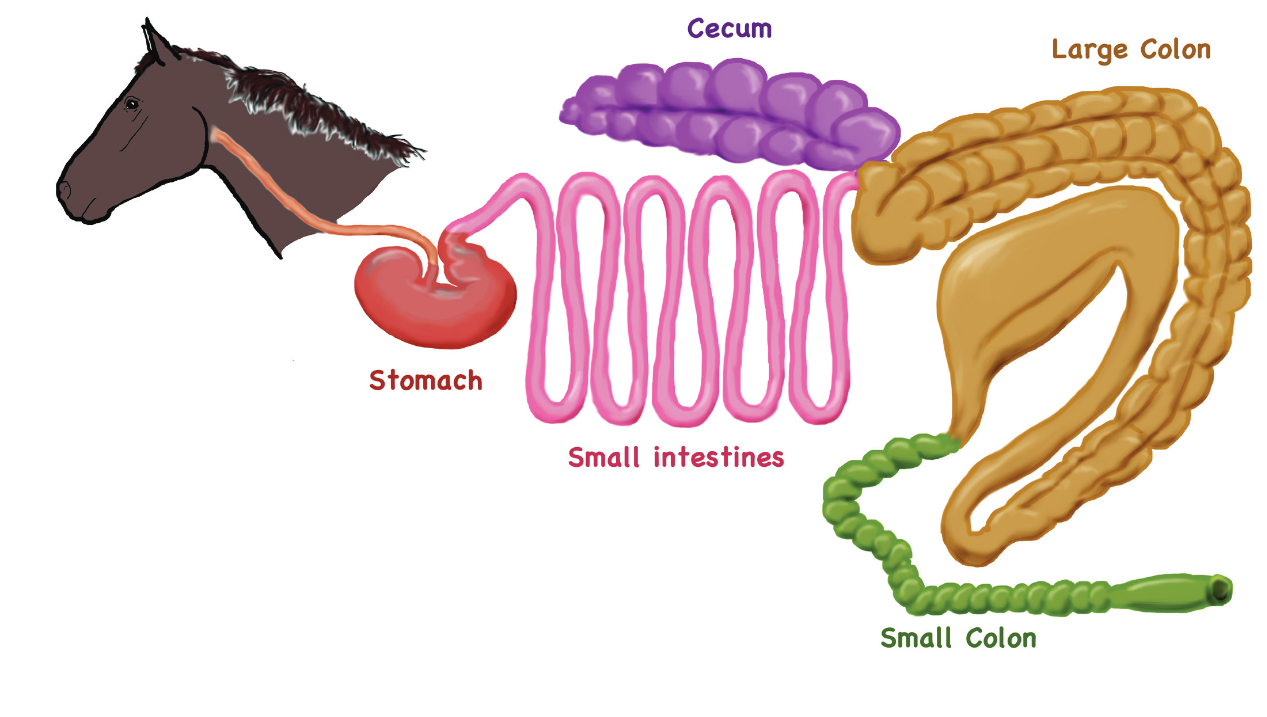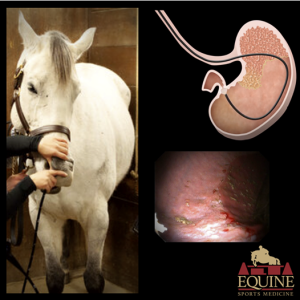115 Gastric Ulcers and Equines
usava001; stock698; and donl0059
Learning Objectives:
- Review of equine digestion.
- Define a gastric ulcer and be able to explain why it occurs.
- Describe diagnosis, treatment, and prevention of gastric ulcers in the equine patient.
Horse Digestion:
- Equines are hindgut fermenters, which means they have a singular stomach similar to humans. Unlike humans, they utilize microbial fermentation in their large colon and cecum. Essentially, they use bacteria and other microorganisms to help them digest their dense fibrous food.
- Once their food reaches the stomach, a combination of gastric juices and mucus provide digestion and protection. Gastric acid plays a role in breaking down food when it arrives in the stomach, while the mucus layer protects the stomach from the gastric acids by creating a thick layer between the gastric acid and the stomach lining. Mucus is secreted by mucus cells.

- The stomach of a horse has 2 major sections:
- The non-glandular stomach is where food arrives first. It is named due to its lack of acid-producing glands. It therefore aids less in the digestion of food and more as a reservoir for copious amounts of food as it enters from the esophagus. There is less protection from acid in this part of the stomach.
- The glandular stomach has a cell type called parietal cells that produce hydrogen chloride (HCl), which is the primary stomach acid. Chewing stimulates the parietal cells to produce more acid in anticipation of a tasty meal coming their way. This stomach acid continues the digestion process before sending the food into the small intestine. This part of the stomach is protected well from acid.
- The horses stomach evolved to produce gastric acid 24/7 because they are constantly grazing.
Gastric Ulcers:
- Gastric ulcers are sores that form on the stomach created when the pH in the stomach becomes too acidic. That means that the stomach is producing too much HCl for the amount of food that it has to break down. They can also occur when the stomach acid splashes up from the protected glandular stomach into the unprotected squamous stomach. Horses are more prone to ulcers if they:
- Eat more grain than roughage
- Don’t have access to constant foraging sources
- Are high performance horses (the physical activity of a performance or working horse cause physical movement of the gastric acid into the non-glandular part of the stomach and cause ulcers there)
- Are mentally or physically stressed
- Are on stall rest or are hospitalized
- Currently (or recently) taking certain medications such as NSAIDs (non-steroidal anti-inflammatory drugs). NSAIDs decrease the amount of mucus produced in the stomach so the stomach lining is more at risk for coming into contact with the gastric acid and creating an ulcer.
- Ulcers can take some time to form. Think about trying to clean a wall that someone has covered in goo. The wall is the stomach lining, the goo is the mucus layer, and you trying to wash off the goo is the gastric acid. You’re not going to get it all off on the first try! In the same way, one splash of gastric acid against the stomach lining or one hour without food isn’t likely to immediately cause an ulcer.
Signs and Symptoms of Gastric Ulcers:
- A majority of horses appear completely healthy with no outward signs or symptoms.
- Subtle changes in the horses behavior may be noted, such as:
- Poor appetite, weight loss or poor body condition
- Poor coat quality
- Acute or recurrent colic, particularly after eating
- Performance issues or reluctance to train
- Changes in attitude or behavior
- Frequent lying down or noted dullness
- More serious ulcer cases may show signs of abdominal pain or grinding their teeth.
Diagnosis:
- In order to diagnose a gastric ulcer, a thorough physical exam and history should be taken. Endoscopy is the easiest way to definitively diagnose an ulcer. Endoscopy is basically a very small camera attached to a long tube that is passed through the nose, down the esophagus and into the stomach to visualize the stomach lining.
-

A long tube with a camera on the end is passed into the horse’s stomach to see if there are ulcers on the internal surface of the stomach.
Treatment and Prevention:
- The best way to treat an ulcer is to prevent it!
- Dietary management is an important part of gastric ulcer prevention. Too much grain, sugars/starches and not enough forage can affect their normal digestion patterns. Because they are constantly producing gastric acids, if they don’t have anything in their stomach to digest they are more likely to develop an ulcer.
- Providing adequate time to performance horses for resting and digesting.
- Horses should be allowed free-choice grass or hay, when possible, to help neutralize the gastric acid that is constantly being produced.
- But if you find yourself confronted with a gastric ulcer…
- Make environmental modifications to ensure there is proper foraging, reduced stress and optimal digestion conditions for a horse as listed above.
- There are medications that can be given that reduce the amount of acid produced by the stomach that will in turn reduce the amount irritation on the stomach lining.
- There are also medications that help protect the stomach lining so that the stomach lining has time to heal and is not further irritated by the stomach acids.
Activities
Use your new knowledge to work through Diesel’s case.
Knowledge Check

